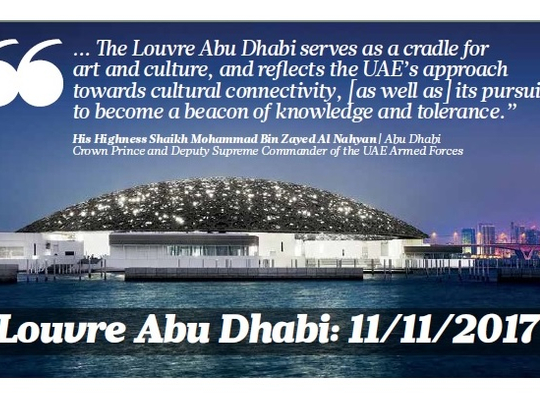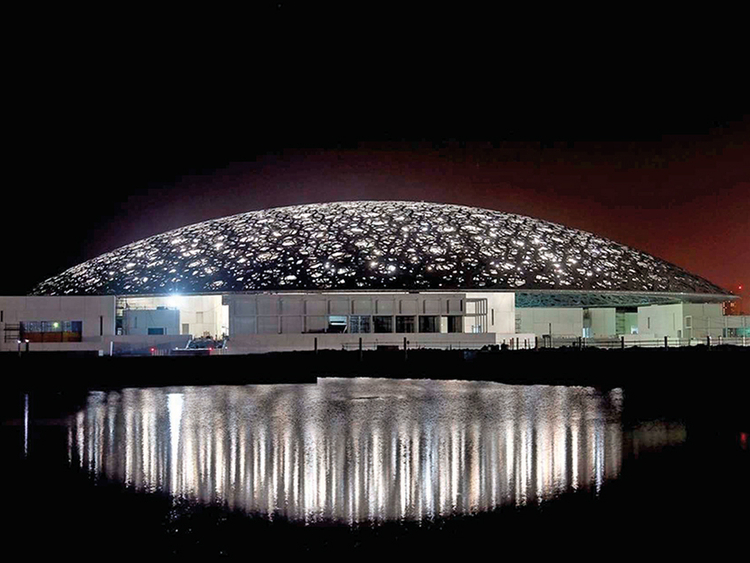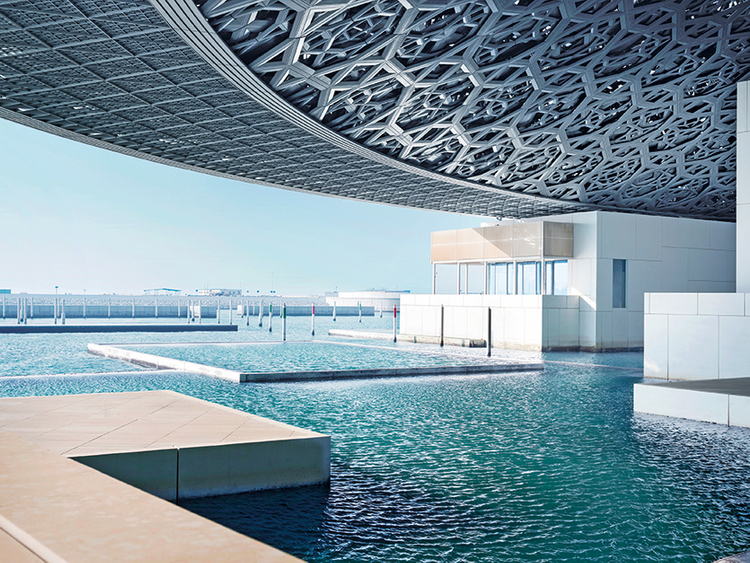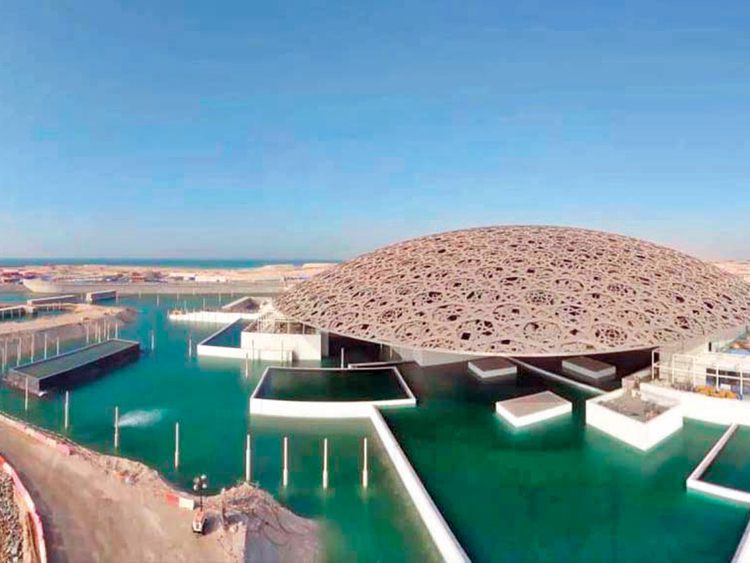
After much anticipation, the iconic Louvre Abu Dhabi museum on Saadiyat Island is set to open its doors on November 11 (2017), top officials announced in the capital on Wednesday.
"On the 11th of November, the Louvre Abu Dhabi will open its doors. And the world will see itself in this museum," said Mohammad Khalifa Al Mubarak, chairman of the Abu Dhabi Tourism and Culture Authority and chairman of the Tourism Development and Investment Company (TDIC) at a press conference.
"The establishment of such a museum is a landmark in the history of art...and shows the commitment [of the UAE and France] to peace and diversity," said François Nyssen, French culture minister.
The first of three museums to open in Saadiyat Island, the 97,000-square-metre Louvre by TDIC, Saadiyat Island master developer, will include 23 permanent galleries in 12 sequences.
"The UAE boosts its global cultural presence with the opening of Louvre Abu Dhabi in November 11. It serves as a cradle for art & culture." pic.twitter.com/oaKjxIeGDV
— أخبار محمد بن زايد (@MBZNews) September 6, 2017
The concept of the museum was born from an intergovernmental agreement between Abu Dhabi and France in 2007. “The Louvre Abu Dhabi and its universal story embodies the spirit of openness and dialogue among cultures, displaying works of historical, cultural and sociological significance from different times and civilisations,” the TDIC has said.
READ MORE:
Louvre Abu Dhabi to feature more than 600 artworks
Louvre Abu Dhabi: Work of art in the works
Louvre Abu Dhabi a marvel in the making
The museum has been designed by Jean Nouvel, a French architect who has been awarded the Pritzker Prize, a top recognition in the field of architecture. Inspired by the medina (the old walled part of a town) and low-lying Arab settlements, Nouvel applied a contextual approach to the site, designing the Louvre Abu Dhabi as a ‘museum city’ in the sea with its contrasting series of 55 white buildings.
The 180 meter-wide and eight-layered dome covers the majority of the museum, and is one of its defining features. The dome’s complex pattern is the result of a studied geometric design, repeated at various sizes and angles in the eight superimposed layers. So each ray of sunlight that hits the dome has to penetrate the eight layers before appearing then disappearing, creating a cinematic effect inside the structure.
In addition to art galleries, the facility includes a temporary exhibition space, a children’s museum, a 200-seater-auditorium, a restaurant, a café, and retail space.
Permanent collection
Once open, the museum’s 600-piece permanent collection, as well as important loaned artworks from prestigious French institutions, will form an art historical narrative taking the visitor from ancient times to the contemporary.
In fact, about 300 artworks from 13 key French institutions will be on display in the opening year alone, including paintings by Leonardo da Vinci’s and Edouard Manet.
The Louvre Abu Dhabi was originally set to open in 2012, but that date was pushed back to late 2014, and then late 2016.
It will be the first of three museums on Saadiyat Island, and will be followed by the openings of the Zayed National Museum and the Guggenheim Abu Dhabi.
Ticket prices
Dh60 for adults
Dh30 for 13-22 years
Dh30 for education professionals
Free entry for children 13 years and younger, members of the museum’s loyalty programme, International Council of Museums members, members of the International Council on Monuments and Sites, journalists, visitors with special needs and their companions
A walk through the gallery
Louvre Abu Dhabi’s story will begin in the “Great Vestibule”, where visitors will be introduced to important themes such as maternity and funerary rituals.
The dialogue between works from different geographical territories will highlight similarities between the canons despite each having its own mode of expression.
The galleries will be both chronological and thematic, and subdivided into 12 chapters.
Displays include works from the earliest empires, including the first figurative representations, such as the Bactrian Princess created in Central Asia at the end of the 3rd Millennium BCE, funerary practices of ancient Egypt illustrated by a set sarcophagi of Princess Henuttawy, and the creation of new economies with Decadrachma coin of Syracuse signed by the artist Euainetos.
A gallery dedicated to universal religions will feature sacred texts: a Leaf from the “Blue Quran”, a Gothic Bible, a Pentateuch and texts from Buddhism and Taoism.
The artistic exchanges on the trading routes during the Medieval and Modern periods will be shown through a number of ceramic works.
Between Asia and the Mediterranean and then between Europe and America, guests will appreciate how the world’s horizon gradually expanded.
A set of screens from the Japanese Namban will demonstrate the dialogue between the Far East and Europe.
From the image of the Prince throughout the world, illustrated by an important Ottoman Turban Helmet to a more intimate vision of a new art of living, the museum will present a chest of drawers made in Red Chinese lacquer by Bernard II Van Risenburgh in France.
In a section about Modernity will be Edouard Manet’s The Gypsy, Paul Gauguin’s Children Wrestling, Piet Mondrian’s Composition with Blue, Red, Yellow and Black.
On show will be a work by the artist Ai Weiwei and his questioning of globalisation.
Louvre Abu Dhabi’s first site-specific works installed in the outdoor areas by contemporary artists will also interact with the spirit of the museum and the fabric of the architecture.
American artist Jenny Holzer has created three engraved stone walls named For Louvre Abu Dhabi.
These cite important historical texts from Ibn Khaldun’s Muqaddimah, the Mesopotamian bilingual (Akkadian / Sumerian) Creation Myth tablet, and the 1588 annotated edition of Michel de Montaigne’s Les Essais.
Italian artist Giuseppe Penone (1947) has produced several works specifically for Louvre Abu Dhabi. Leaves of Light is a vast bronze tree with mirrors placed in its branches to reflect the ‘rain of light’.
Propagation is a wall of porcelain tiles that depict hand-drawn concentric circles originating from the fingerprint of Shaikh Zayed, the UAE’s founding father.
It was produced in collaboration with the workshops of Sèvres – Cité de la céramique in France.
Source: Louvre Abu Dhabi
Louvre Abu Dhabi in numbers
Number of ‘stars’ that form the dome’s eight layers of cladding: 7,850
Number of super-sized elements that compose the dome: 85
Weight of each super-sized elements: up to 50 tonnes
Highest point of the dome: 40 metres above sea level and 36 metres above ground floor level.
Interior dome elevation: 29 metres above ground-floor level.
Number of permanent piers holding up the dome: 4
Dimensions of largest ‘stars’: 13 metres in diameter and 1.3 tonnes in weight.
Total weight of the dome is 7,500 tonnes (weighing almost as much as the Eiffel Tower) which is broken down into the following:
Dome steel structure: 5,200 tonnes
Inner and outer cladding, perimeter rim: 2,000 tonnes
Gratings, walkways, mesh and misc. items: 300 tonnes
Number of scaffoldings used during construction: 120
Lifting weight capacity of super-sized cranes used on site: 1,600 tonnes
Height of 1,600 tonne-capacity crane: 230 metres
Number of trucks used to transport the crane: 90 trucks
The underground service tunnel that will connect Louvre Abu Dhabi, Zayed National Museum and Guggenheim Abu Dhabi is over 1km in length.

















